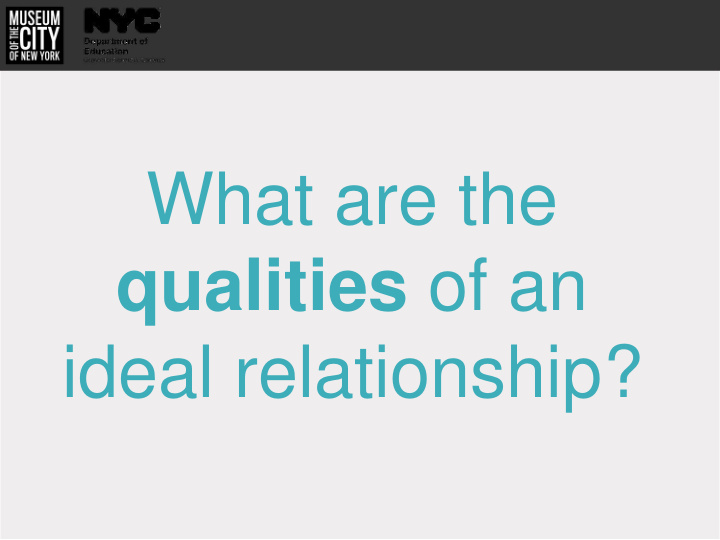



What are the qualities of an ideal relationship?
The Power of Collaboration: LGBTQ Inclusion Within and Beyond the Museum May 21, 2018 Jared Fox | New York City Department of Education Lauraberth Lima | Museum of the City of New York
Welcome + Introduction from Presenters + Group Introductions - Name - Personal Gender Pronouns (optional) - Institution
Agenda + Group Norms + Objectives + Format + Concept of Collaboration + Case Studies & Discussion + Tips
Group Norms + Listen to understand, not reply Use “I” statements + + Assume the best intentions Platinum Rule: treat others as “they” would like to be treated + Maintain respect for and confidentiality of all people’s opinions +
Objectives + We will engage with each other to consider various topics around LGBTQ inclusion in museums with the goal of reaching beyond the Museum walls. + We will consider potential strategies that Museums can employ to build upon LGBTQ communities and audiences through strong collaborations. + We will discuss challenges and success that we are experiencing in our respective institutions. + We will leave with tips for effective practices.
Format + 1. Presenters will share case study examples. + 2. Participants will have a brief moment to reflect and write down ideas. + 3. Presenters will pose questions to guide discussion.
What are the qualities of an ideal relationship?
Case Study #1: Commitment to Content + Regular inclusion of content: “Normalizing” LGBTQ experience + Build consistent trust: with LGBTQ communities and audiences + Setting the foundation: Going beyond barriers and doing the work to be ready for partnerships Activist New York , Museum of the City of New York
Case Study #1: Commitment to Content Gay Gotham: Art and Underground Culture New York has long been a beacon for lesbian, gay, bisexual, and transgender artists seeking freedom, acceptance, and community. Gay Gotham: Art and Underground Culture in New York brings to life the queer creative networks that sprang up in the city across the 20th century — a series of artistic subcultures whose radical ideas had lasting effects on the mainstream.
Case Study #1: Guiding Questions + What does true inclusion for LGBTQ communities look like in a Museum? + How might your partners help to inspire and uphold your institutional values?
Case Study #2: Being a Resource + Skills: Teaching NYCDOE teachers how to teach LGBTQ History + Mindset: Changing culture and ideology through regular inclusion + Resources: Content (i.e. Primary Sources and Lesson Plans) www.mcny.org/lesson-plans
Brain Pop
Case Study #2: Guiding Questions + What is the significance of representing and teaching LGBTQ history at Museums to all demographics? + How might this work plant seeds?
Case Study #3: Cultivate Community Experts: Consider who are the “experts” within and beyond your institution. + + Structural Impact: Avoid reinforcing systems of power (i.e. pay people and do not expect emotional labor). + Multi modality: Reconsider where and how learning can happen. Agency: Avoid “tokenism” and share authority in decision making. +
Case Study #3: Guiding Questions + How can stakeholders and experts within the community enhance the work that you are doing? + How might being understanding of and flexible to other modes of working (i.e. governmental, community based, or unconventional spaces) support your goals?
Case Study #4: Modeling Change + LGBTQ Teen Summit at MCNY + Show up: Continuous support and fellowship + Challenge structures of power: in order to show up for others
Case Study #4: Modeling Change
Case Study #4: Guiding Question + How might Museum Educators, through collaboration, design programming with impact that reaches beyond the Museum walls?
Case Study #5: Being an Ally + Ally = ACTION + Seek and Affirm policies and guidelines in place + Create Space for Others: Department of Education Employee Resource Group & Badges + Do your work
Case Study #5: Guiding Question + How might we build relationships with our partners, visitors, and museum colleagues to provide support that goes deeper than programs? + How might this support benefit our colleagues and the field at large? For example: avoiding burnout
Quick Tips For Collaboration 1. Know your institution. What potential barriers are you working through and what resources are available to support you? Does your institution have a DEAI Committee? 2. Know your community and beyond. What stakeholders or experts surround you? What work is already being done? How can you be a support to others? 3. Meet people where they are at. The perfect program or partnership is not always perfect. 4. Maintain Relationships. Show up and check in regularly. 5. Give over the power. Be okay with not always being the expert and be willing to share authority for the greater good of your audience. 6. Make emotional and physical space for others. It is okay to step back, make referrals, to not take a job, speak up in order to make space for LGBTQ communities. 7. Be open minded and flexible. As the LGBTQ community grows, so do the needs and language. 8. Do your Research. Know your biases, plan ahead, develop boundaries and BE BRAVE.
Thank You! Lauraberth S. Lima Jared Fox Family and Community Engagement Coordinator Lesbian, Gay, Bisexual, and Transgender Internship In Museum Education Coordinator (LGBT) Community Liaison Museum of the City of New York New York City Department of Education 917-492-3438 (NYCDOE) llima@mcny.org 212-374-6908 jfox16@schools.nyc.gov
Recommend
More recommend